
Haiti President Michel Martelly (left) and UNAIDS Executive Director Michel Sidibé at the Ministry of Planning in Port-au-Prince.
Credit: UNAIDS
The President of Haiti ushered in World AIDS Day 2012 commemorations with a note of hope. “It would be a very beautiful success story if we could pull off an HIV-free generation,” declared President Michel Martelly, in a meeting on 30 November with UNAIDS Executive Director Michel Sidibé.
In 2011, an estimated 77% of pregnant women living with HIV in Haiti had access to services that prevent mother-to-child transmission (PMTCT) of HIV. Between 2009 and 2011 the country secured a 25% decrease in the number of children born with HIV.
“Getting to zero HIV infections in children should be the legacy of this administration,” said Mr Sidibé. “It would be a very powerful accomplishment. Two children are born with HIV in Haiti each day. Think of what it would mean if we could leave behind a generation that was born HIV-free,” he added.
It would be a very beautiful success story if we could pull off an HIV-free generation.
Michel Martelly, President of Haiti
President Martelly noted the moral and economic imperatives of preventing HIV in children, saying that while it costs only US $150 to prevent a child being born with HIV, it would cost hundreds of thousands of dollars to treat a person living with the virus over the course of their lives. “If you can save a mother,” he added, “you prevent a child from becoming an orphan.”
In separate meetings with Haiti’s First Lady, Sophia Martelly, and the Minister of Health, Florence Guillaume Duperval, Mr Sidibé stressed that Haiti has the potential to eliminate HIV in children and dramatically reduce AIDS-related deaths in mothers. The First Lady pointed to national efforts geared toward achieving these twin goals, including a campaign to ensure that more pregnant women—particularly those living in rural areas—access HIV testing and treatment services.

Haiti First Lady Sophia Martelly (left) and UNAIDS Executive Director Michel Sidibé at Haiti's National Palace in Port-au-Prince.
Credit: UNAIDS
The Caribbean has the highest PMTCT coverage of any developing region. Many smaller Caribbean countries are already close to eliminating new HIV infections among children. Further scale-up of PMTCT services in Haiti—one of the region’s most populous countries—will help the entire Caribbean reach closer to the goal of eliminating new HIV infections among children, a key target of the 2011 Political Declaration on HIV/AIDS.
In addition to PMTCT scale-up, Haiti has progressed in other areas of its national HIV response. Between 2001 and 2011, for example, new HIV infections in the country declined by 54%. Haiti also attained a 47% decline in AIDS-related deaths from 2005 to 2011.





